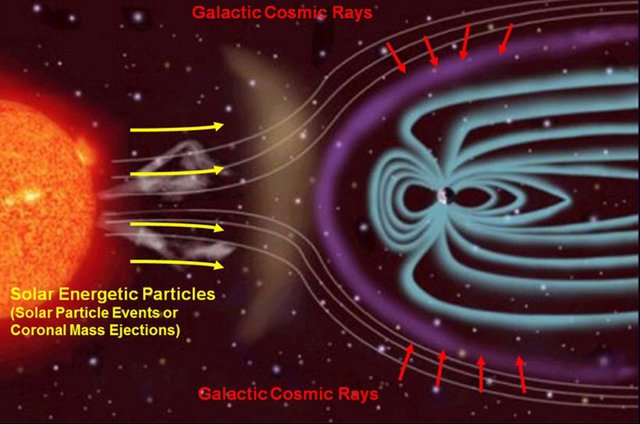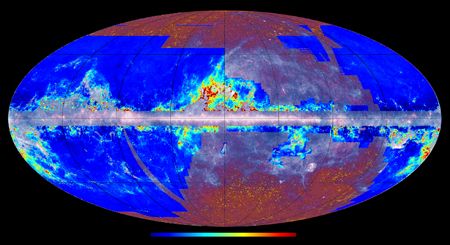You are viewing a single comment's thread from:
RE: Electromagnetism: A Result of Gravity
Hello, I really like your theory and your explanations and agree with them. Probably another proof for this theory are the two milky way gigantic X-ray/gamma-ray bubbles. What I can see here is another figure-8 orbit. Could those bubbles be the "electromagnetic field" of the galaxy? https://en.wikipedia.org/wiki/Milky_Way#Galactic_Center
Hey Jim, I did some more looking into this and I found that this observation is also found in radio waves but what is most interesting is the shape of these "lobes":
Source
As they distinctly trail to one side, I was immediately reminded of the Earth's electromagnetic field as it is affected by the sun:

Source
This would suggest that the Milky Way's central black hole's electromagnetic field is influenced the same way by an even more massive object that it orbits. That object, too, would radiate an equivalent "solar wind" that would effectively push the electromagnetic field of our galaxy in a similar manner. Notably, radio waves are less energetic than x-rays, and thereby are composed of less massive particles, and so they would be more easily influenced by the "solar wind".
If we look at the Fermi all-sky survey of the X-ray "bubbles", they too are somewhat "bent" to the same side as the radio waves but it is less substantial:
Source
This gives credence to the concept that this is an observation of portions of our galaxy's black hole's electromagnetic field, which is composed of a wide range of different masses of particles. Lower mass particles such as radio waves are more easily influenced and their trajectory bends sooner, creating "inner" rings of a given electromagnetic field (such as the image of Earth's above). Higher mass particles are influenced by gravity less and are able to travel further away, alike to the outer rings of Earth's electromagnetic field.
Another interesting piece of information is that these "lobes" and "bubbles" are known to be "magnetized", which makes sense if they are an electromagnetic field.
With the radio wave image, I am much more confident that these are portions of the electromagnetic field of our galaxy's supermassive black hole actually being directly observed. Thanks again for pointing this out to me! I will let you know if I come across more information. I may do a full post on this topic here on Steemit once I have digged some more and reference you and your question, if that's ok. :)
Thank you very much for approaching this observation deeper and in more detail! Good to notice that the image actually shows two lobes rather than bubbles (similar to earth's magnetic field interacting with solar wind) so we can clearly view it as a "bent" galactic electromagnetic field. I agree with it.
I am not so experienced with astrophysics as you are, the reason that I pointed this out was because this image appeared to me as another example showing that systems at any scale operate the same as you have said, triggering an interpretation from your side which would include the similarities with our closer earth/sun levels, just as you did with your reply.
So, the more examples we have, the more puzzle pieces are revealed and the clearer the image appears.
Of course, I really like your work and I would be happy to read more posts on this or any other topic.
It is definitely my pleasure! There are other observations as well, the first known as the Microwave Haze:
Source
and another known as the Planck Haze:

Source
While I feel confident that they are all likely direct observations of the electromagnetic field of our galaxy's central black hole and the effects of an external "solar wind" on it, I know there are extensive studies on these structures such as found in this paper, "A Unified Model of the Fermi Bubbles, Microwave Haze, and Polarized Radio Lobes: Reverse Shocks in the Galactic Center’s Giant Outflows", so I will definitely look through the research on these for observational descriptions to assist.
Interestingly, there is also a practice of measuring the velocity of these structures by using the light from supernovas going through the clouds to determine the motion. What I was unable to find, though, was research for the velocity of each structure independently. At most, it appears that the motion of the northern Fermi bubble was measured and the motion of the southern bubble was assumed to be the same. What I was trying to find was evidence of each's motion, as if it is observational evidence of the electromagnetic field of our galaxy then we would anticipate one side to flow outward (as they measured) but the other to be flowing inward (unknown but assumed to be outward).
I will have to do some more thorough searching into this to find more details to draw conclusions on, as right now I have only done a cursory search and drawn conclusions from the parallels between these structures and how other systems function. Maybe there is a measurement of the southern lobe's motion somewhere, which would be critical.
Exactly :) I will be writing a post specifically describing as many parallels between structures (galaxies, solar systems, planetary systems--black holes, stars, planets--etc) as possible to try to detail why adjacent levels function the same and how this is only logical to extrapolate outward infinitely.
Thanks for your interest! I imagine you went through my posts pretty well to even be commenting on this old post, but I do have lots of information in my posts that is all connected, feel free to browse through them at your leisure! My website has my research paper, its accompanying video, and a short book all here. I will hopefully be posting in the next few days on that subject and maybe this one as well when I feel more comfortable about the observations and more strongly about specifically what is happening. :)
Hi, thanks! I appreciate your interest greatly!
As far as these bubbles, this is the first time I came across them actually, so thanks for pointing them out to me! I find it interesting that they form perpendicular to the disc of the galaxy. I would expect the disc of our galaxy to be the result of a rotating "black hole" that leads to the disc much the same as the Kuiper belt of our solar system, to the Van Allen belts of Earth and to rings of planets such as Saturn, which would imply our galaxy's central black hole rotates along an axis generally perpendicular to the disc of the galaxy, i.e. parallel to these bubbles. If it were the totality of the electromagnetic field then it would suggest the poles, then, are parallel to the disc of the galaxy which doesn't seem right.
My take would be that particles of the electromagnetic field of our galaxy's black hole traveling out of and into its poles are relatively densely packed (due to converging on the center of gravity) in these regions so as to create a "glow" due to the amount of energy present there. As the particles disperse along their particular trajectories into the whole of the electromagnetic field, their density in more outward regions would decrease and the apparent visual effects would diminish until the particles rejoin again into higher density at the opposite pole so that we may only be able to see such effects "near" the poles, like the auroras of Earth, but not elsewhere.
In this interpretation, I would add that they are not necessarily "bubbles" in an electromagnetic field shape kind of way but may just be regions of the electromagnetic field that are energetically dense (as the electromagnetic field north and south pole regions of the black hole) which appear generally like bubbles and have been interpreted as such. This observational image is a bit less "bubbly" than this artist rendition, for example. The importance of this nuance being that if they are bubbles this suggests a boundary whereas if they are areas of higher density in the electromagnetic field, then those boundaries are less tangible and only a visual result. If they are the electromagnetic field as a whole (as bubbles), then the Figure-8 is perpendicular to the disc of the galaxy which doesn't seem right, but if they are regions of the Figure-8 that depict the poles, then the electromagnetic field would be more in agreement with the shape of the galaxy, so I would strongly lean towards that being the case. Just my initial take on it; I will definitely keep it in mind!
I would also note that it reminds me of the 3dz2 orbital., which I find interesting.
For sure though they are related to the electromagnetic field of our galaxy's black hole and ultimately are the result of gravity. The mainstream interpretations I am reading on this observation are a bit perplexing. From NASA: "The feature spans 50,000 light-years and may be the remnant of an eruption from a supersized black hole at the center of our galaxy." This seems a bit ridiculous to me to assign it to the result of some other object than our galaxy's central black hole. :)